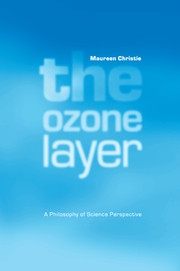Book contents
- Frontmatter
- Contents
- List of figures
- List of abbreviations
- Preface
- 1 Introduction
- Part I History of the understanding of stratospheric ozone
- 2 Stratospheric ozone before 1960
- 3 Chlorinated fluorocarbons
- 4 The Supersonic Transport (SST) debate
- 5 Molina and Rowland: chlorine enters the story
- 6 Too much of a good thing? Crucial data backlog in the Antarctic ozone hole discovery
- 7 Antarctic ozone hole – theories and investigations
- 8 Completing the picture: from AAOE to 1994
- Part II Philosophical issues arising from the history
- References
- Index
8 - Completing the picture: from AAOE to 1994
Published online by Cambridge University Press: 22 September 2009
- Frontmatter
- Contents
- List of figures
- List of abbreviations
- Preface
- 1 Introduction
- Part I History of the understanding of stratospheric ozone
- 2 Stratospheric ozone before 1960
- 3 Chlorinated fluorocarbons
- 4 The Supersonic Transport (SST) debate
- 5 Molina and Rowland: chlorine enters the story
- 6 Too much of a good thing? Crucial data backlog in the Antarctic ozone hole discovery
- 7 Antarctic ozone hole – theories and investigations
- 8 Completing the picture: from AAOE to 1994
- Part II Philosophical issues arising from the history
- References
- Index
Summary
The data from the AAOE provided a strong direct confirmation of the chlorine theories generally, as opposed to circulation or solar cycle theories. Important parts of the story had been correctly anticipated by some of the chlorine theories: the involvement of reactions at ice-crystal surfaces, dimerisation of ClO (i.e. ClO+ClO → ClOOCl), dissociation of Cl2 and HOCl by visible light, and the involvement of bromine species (though only as a minor contributor; not as the main channel). A large degree of consensus was reached among the community of atmospheric scientists, and some closure of many of the aspects of the problem. A fairly clear course was mapped out for further investigation, and resolution of the fine details of mechanism. This was largely achieved in the few years immediately following the AAOE.
The 1994 WMO report addresses the issues in a rather more confident tone than the earlier reports: the emphasis changed from outlining the large uncertainties that still needed to be resolved, to discussing fine details of the modelling, comparing models, and pointing out problems with some input parameter values, or gaps in the observational data set. Likely future implications of various public policy scenarios were modelled and presented with greater certainty and authority.
But the tone of confidence in the report does not run very deep. Examples of remaining problems with the detail of the currently accepted mechanisms are not hard to find.
- Type
- Chapter
- Information
- The Ozone LayerA Philosophy of Science Perspective, pp. 66 - 70Publisher: Cambridge University PressPrint publication year: 2001



